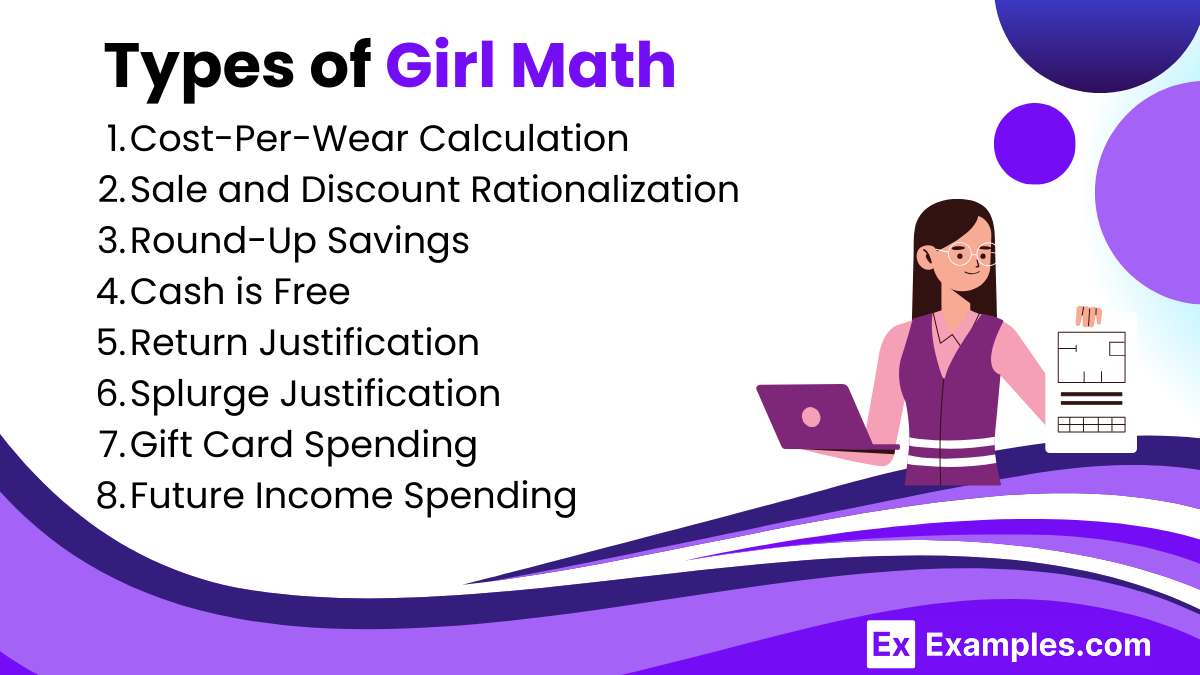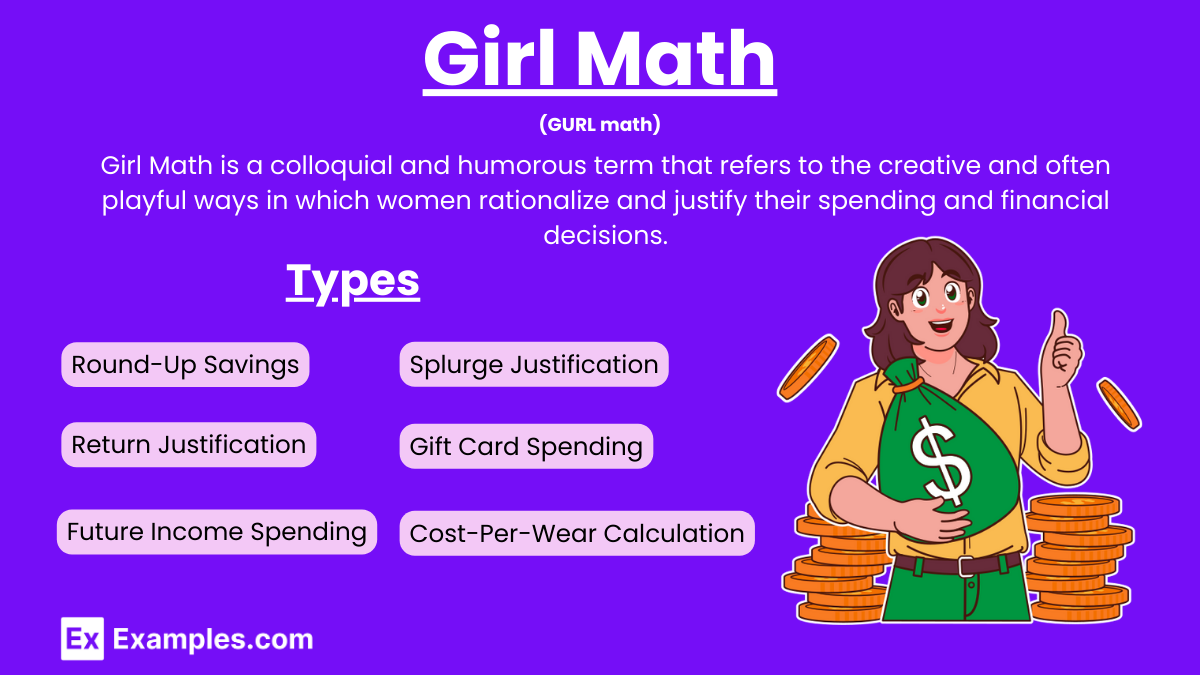23+ Girl Math Examples
“Girl Math” is a playful and humorous term often used to describe the unique and sometimes unconventional ways in which women justify their spending habits and financial decisions. It can encompass a range of behaviors, from rationalizing a purchase by breaking it down into cost-per-wear to finding creative ways to budget for a desired item. While the term is lighthearted, it also reflects broader themes of how individuals approach personal finance, blending practicality with a touch of creativity.
What is Girl Math?
In celebrating women and their unique approaches, activities such as designing a Women’s Day Flyer can promote events that highlight these themes. Delivering a Women Empowerment speech can address how financial independence and smart money management are crucial for empowerment. Workshops on Assertive Communication for Women can also include discussions on financial decision-making. An Essay on Women Empowerment might explore how concepts like “Girl Math” reflect broader societal trends and the empowerment of women through financial savvy. Using a simile to describe a girl can add a creative touch to these discussions, illustrating the blend of practicality and creativity in women’s financial approaches.
Examples of Girl Math
- Justifying a purchase because it’s on sale
- Rounding down the price of an item to make it seem cheaper
- Buying in bulk to save money in the long run
- Considering money spent on experiences (like vacations) as more valuable than on material items
- Buying an expensive item to earn reward points or cashback
- Justifying a purchase by comparing it to a more expensive item
- Considering a purchase as “free” if it was paid for with a gift card
- Buying something now to avoid a price increase later
- Calculating the cost-per-wear of clothing to justify the purchase
- Splurging on an item with the money saved from cutting other expenses
- Considering “returnable” items as not really spending money
- Buying something because of “limited time offer” or “last chance”
- Thinking of items bought with bonus money (like a work bonus) as not coming out of the regular budget
- Purchasing items in different colors or styles to avoid spending more later
- Justifying a luxury item purchase by planning to cut costs elsewhere
What is the Impact of Girl Math on TikTok?
Popularity and Engagement
- Virality: The concept of “Girl Math” has quickly gone viral on TikTok, leading to a surge in user engagement with the hashtag.
- Creativity: Users create humorous and relatable content around their financial justifications, often using the “Girl Math” term.
Community and Connection
- Relatability: The trend has fostered a sense of community among users who share similar spending habits and financial rationalizations.
- Conversations: It has sparked discussions about personal finance, encouraging users to share their own experiences and tips.
Influence on Behavior
- Awareness: By highlighting unconventional spending justifications, it brings attention to various consumer behaviors and financial habits.
- Self-Reflection: Users reflect on their own spending habits and consider more conscious financial decisions.
Educational Aspect
- Finance Talk: While primarily humorous, the trend indirectly educates users about financial decision-making and budgeting.
- Experts Weigh In: Financial experts and influencers use the trend to share advice and debunk common financial myths.
Content Creation
- Trend Participation: Content creators leverage the trend to boost their visibility, often adding their own twist to the “Girl Math” concept.
- Diverse Perspectives: The trend includes diverse perspectives, with users from different backgrounds sharing how they apply “Girl Math” to their lives.
Commercial Impact
- Marketing Opportunities: Brands and influencers capitalize on the trend to market products and services related to finance and lifestyle.
- Consumer Insights: Marketers gain insights into consumer behavior and preferences, influencing product development and marketing strategies.
Types of Girl Math

1. Cost-Per-Wear Calculation
- Description: Justifying a purchase by dividing the total cost by the number of times an item will be used or worn.
- Examples: Buying an expensive dress but rationalizing it because it will be worn multiple times, thus reducing the cost-per-wear.
2. Sale and Discount Rationalization
- Description: Convincing oneself that money is saved by purchasing items on sale or with discounts.
- Examples: Buying items you don’t need just because they are 50% off and viewing it as saving money.
3. Round-Up Savings
- Description: Treating the remaining change after a purchase as savings, especially when using cash.
- Examples: Spending $19.50 out of a $20 bill and considering the remaining 50 cents as “saved.”
4. Cash is Free
- Description: Viewing cash transactions as less impactful than card transactions, often feeling like cash is “free” money.
- Examples: Using cash for small purchases and feeling like they don’t affect your budget as much as card payments.
5. Return Justification
- Description: Considering returned items as a gain or new-found money.
- Examples: Returning a dress and feeling like you’ve gained back the money, almost like getting a bonus.
6. Splurge Justification
- Description: Rationalizing an expensive purchase by promising to cut back on other expenses.
- Examples: Buying a luxury item and justifying it by vowing to skip dining out for a month.
7. Gift Card Spending
- Description: Treating gift cards or store credit as “free money” and spending it more freely than regular cash.
- Examples: Receiving a $50 gift card and feeling less guilty about splurging on non-essential items.
8. Future Income Spending
- Description: Justifying purchases by thinking about future income or bonuses that haven’t been received yet.
- Examples: Buying a high-ticket item and rationalizing it with an upcoming bonus or tax refund.
Girl Math Rules
- Cost-per-wear calculation
- Sale and discount rationalization
- Round-up savings
- Cash is free
- Return justification
- Splurge justification
- Gift card spending
- Future income spending
- Subscription justification
- Group purchase rationalization
Girl Math Quotes
- “If it’s on sale, you’re saving money by buying it now.”
- “Cost per wear makes it practically free!”
- “Returning it means I made money.”
- “If I pay in cash, it’s like it never happened.”
- “Buying in bulk means I’ll never run out, so it’s a good investment.”
- “Using a gift card feels like getting it for free.”
- “I can justify this purchase because I won’t spend on coffee for a week.”
- “The more I buy, the more I save.”
- “Future me will be grateful for this splurge.”
- “If my friends are in, then the cost is practically nothing.”
Girl Math vs Boy Math
| Aspect | Girl Math | Boy Math |
|---|---|---|
| Definition | Creative justification for spending, often emphasizing savings and cost-per-wear. | Logical or straightforward justifications, often emphasizing utility or investment. |
| Approach to Sales | “If it’s on sale, you’re saving money by buying it now.” | “Buy quality once; it’s cheaper in the long run.” |
| Cost Justification | “Cost per wear makes it practically free!” | “It’s a good investment if it lasts longer.” |
| Cash Spending | “If I pay in cash, it’s like it never happened.” | “Cash is king; avoid credit card interest.” |
| Return Justification | “Returning it means I made money.” | “Return it if it doesn’t perform as expected.” |
| Splurging | “I can justify this purchase because I won’t spend on coffee for a week.” | “I’ll splurge on tech because it’s a long-term investment.” |
| Bulk Buying | “Buying in bulk means I’ll never run out, so it’s a good investment.” | “Bulk buying saves trips and time.” |
| Gift Cards | “Using a gift card feels like getting it for free.” | “Gift cards are like cash; use them wisely.” |
| Future Spending | “Future me will be grateful for this splurge.” | “Plan for future expenses to avoid surprises.” |
| Group Purchases | “If my friends are in, then the cost is practically nothing.” | “Splitting costs with friends makes big purchases affordable.” |
| Impulse Buying | “It’s okay to buy this; I’ve been good with my budget lately.” | “I’ll wait for a good deal or review before buying impulsively.” |
| Technology and Gadgets | “It’s the latest model, so it’s worth the splurge.” | “Buy tech for functionality, not just the latest model.” |
Uses of Girl Math
- Justifying Purchases: “Girl Math” is often used to justify spending money on items that might seem extravagant or unnecessary. For example, if a woman buys an expensive dress on sale, she might calculate the “savings” from the discount as a rationale for the purchase, feeling satisfied that she got a good deal.
- Budgeting for Special Occasions: This approach can be used to rationalize spending on special occasions like birthdays, weddings, or vacations. By spreading out the cost over time or comparing it to other potential expenses, it makes the spending seem more reasonable and justified.
- Cost-Per-Use Analysis: “Girl Math” often involves calculating the cost-per-use of an item to justify its purchase. For example, buying an expensive pair of shoes might be rationalized by considering how many times they will be worn, thus reducing the perceived cost per wear.
- Treating Yourself: The concept is frequently used to rationalize self-care or “treat yourself” moments. Buying a pricey coffee every day might be justified by considering it a small, daily indulgence that boosts happiness and productivity.
- Splurging with Discounts: Another use is rationalizing splurges by focusing on the discounts or deals obtained. For example, if a woman buys several items during a major sale, she might emphasize how much she saved rather than how much she spent.
- Future Savings: “Girl Math” might involve the idea of future savings to justify current spending. For instance, investing in a high-quality item now might be seen as saving money in the long run because it won’t need to be replaced as quickly.
- Emotional Value: This approach often includes factoring in the emotional value or happiness derived from a purchase. If buying a particular item brings significant joy or boosts self-esteem, it is considered a worthwhile investment.
- Rewards and Points: Using credit card rewards, loyalty points, or cashback offers is another aspect of “Girl Math.” Purchases might be justified by the points or rewards earned, which can be used for future benefits.
Is Girl Math an official financial term?
No, Girl Math is a playful, informal concept, not recognized in financial literature.
How does Girl Math work?
Girl Math involves creative reasoning to justify expenses, like considering sale savings as earnings.
Why do people use Girl Math?
People use Girl Math for fun and to rationalize purchases without guilt.
Is Girl Math effective for budgeting?
Girl Math is not a practical budgeting tool; it’s more for amusement.
Can Girl Math help save money?
While entertaining, Girl Math is unlikely to help with actual savings or financial planning.
Is Girl Math only for women?
Though termed “Girl Math,” anyone can use these playful justifications for spending.
What are some examples of Girl Math?
Examples include viewing sale discounts as earnings or considering cash purchases as free because it’s not on a card.
Does Girl Math promote financial irresponsibility?
Girl Math is intended as a joke and should not replace responsible financial practices.
How did Girl Math become popular?
Social media platforms and online communities popularized Girl Math through memes and discussions.
Is Girl Math related to retail therapy?
Yes, both involve justifying spending for emotional satisfaction, but Girl Math is more about humorous rationalization.



